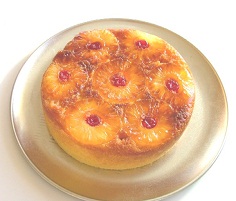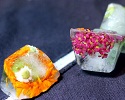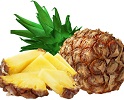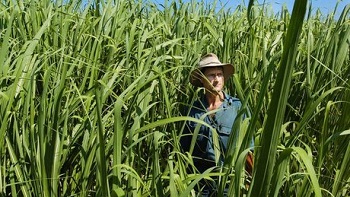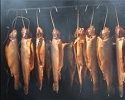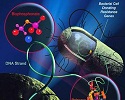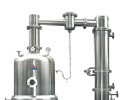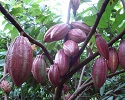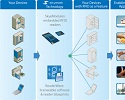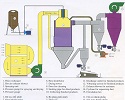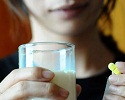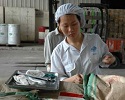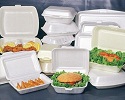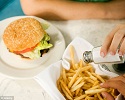|
Ebook Yoghurt Science and Technology
|
|
| trcnam | Date: Thứ Ba, 28-08-2012, 0:26 AM | Message # 1 |
|
Cấp bậc: Food-6
Quyền: Quản Trị Cấp Cao
Số bài đăng: 167
Cảm ơn: 1
Hiện đang: Offline
| Ebook Yoghurt Science and Technology
A. E. Tamime và R. K. Robinson
Content
Preface to second edition
Preface to first edition
1 Historical background
1.1 Introduction
1.2 Evolution of the process
1.3 Diversity of fermented milks
1.4 Patterns of consumption
1.5 Methods of production and classification
1.6 References
2 Background to manufacturing practice
2.1 Introduction
2.2 Preliminary treatment of the milk base
2.2.1 Milk as a raw material
2.2.2 Separation of cellular matter and other contaminants present in milk
2.2.3 Milk reception and storage
2.3 Standardisation of fat content in milk
2.4 Standardisation of the solids-not-fat content in milk
2.4.1 Traditional process
2.4.2 Addition of milk powder
2.4.3 Addition of buttermilk powder
2.4.4 Addition of whey powder and/or whey protein concentrates
2.4.5 Addition of casein powder
2.4.6 Concentration by vacuum evaporation (VE)
2.4.7 Concentration by membrane filtration
2.4.8 Addition of non-milk proteins
2.5 Addition of stabilisers/emulsifiers
2.5.1 General background
2.5.2 Miscellaneous properties and conditions
2.6 Addition of sweetening agents
2.6.1 General introduction
2.6.2 Types of carbohydrate sweetener
2.7 Addition of miscellaneous compounds
2.7.1 Penicillinase
2.7.2 Preservatives
2.7.3 Minerals, vitamins and/or fatty acids
2.8 Homogenisation
2.8.1 Effects on milk constituents
2.8.2 Aspects of processing
2.9 Heat treatment
2.9.1 Destruction of micro-organisms/pathogens
2.9.2 Production of stimulatory/inhibitory factors
2.9.3 Changes in the physicochemical properties of milk
2.9.4 Processing effects on the physical properties of the gel
2.10 Fermentation process
2.10.1 Introduction
2.10.2 Starter organisms
2.10.3 Gel formation
2.11 Cooling
2.11.1 One-phase cooling
2.11.2 Two-phase cooling
2.12 Addition of fruit/flavouring/colouring ingredients
2.12.1 Fruits
2.12.2 Flavouring agents
2.12.3 Colouring matter
2.13 Packaging
2.13.1 Introduction
2.13.2 Functions of packages
2.13.3 Types of packaging materials
2.13.4 Comparative studies on permeability of different yoghurt packages
2.13.5 Migration of monomers and other compounds
2.13.6 Tamper-evident packaging
2.13.7 Aluminium foil lids
2.13.8 Sterilisation of packaging materials
2.13.9 Outer or shipping container
2.14 Refrigerated cold storage, transport and distribution
2.14.1 The cold store
2.14.2 During transport
2.14.3 The retail shop and the consumer
2.15 Conclusion
2.16 References
3 Processing plants and equipment
3.1 Home or small-scale production
3.1.1 Miscellaneous systems
3.1.2 Packaging system
3.2 Medium-scale production
3.2.1 Hand operated vat
3.2.2 Multipurpose vat
3.2.3 Mini dairy
3.2.4 Small-scale packaging machines
3.3 Large-scale production
3.3.1 Milk reception, handling and storage
3.3.2 Standardisation of fat content in milk
3.3.3 Fortification of milk solids
3.3.4 Homogenisation
3.3.5 Heat treatment
3.3.6 Fermentation/incubation of the milk
3.3.7 Cooling
3.3.8 Pumps
3.3.9 Miscellaneous fittings
3.3.10 Fruit handling and mixing units
3.3.11 Filling machines
3.3.12 Miscellaneous handling, chill cooling and refrigerated cold storage
...
Vượt lên mọi thách thức!
"If you born Poor, it's not your Mistake!
But if you die Poor, it's your Mistake!"
|
| |
Mẹo: Nhấn "Thích" "G+" để thank trcnam!     | |  |
| |
| trcnam | Date: Thứ Ba, 28-08-2012, 0:27 AM | Message # 2 |
|
Cấp bậc: Food-6
Quyền: Quản Trị Cấp Cao
Số bài đăng: 167
Cảm ơn: 1
Hiện đang: Offline
| 3.4 Mechanisation of yoghurt production and plant design
3.5 Continuous yoghurt production
3.5.1 Background
3.5.2 The NIZO process
3.5.3 Recent developments
3.6 Automation/process control
3.6.1 Levels of automation
3.6.2 Area/department 1
3.6.3 Area/department 2
3.6.4 Area/department 3
3.6.5 Area/department 4
3.6.6 Area/department 5
3.6.7 Area/department 6
3.6.8 Management information system
3.6.9 System architecture
3.6.10 System security
3.7 Building design, maintenance and services
3.7.1 General background and introduction
3.7.2 Location of a dairy plant
3.7.3 Layout of a dairy plant
3.7.4 Design and construction of dairy buildings
3.8 Conclusion
3.9 References
4 Plant cleaning, hygiene and effluent treatment Cleaning aspects
4.1 Primary objectives
4.2 Principles of the cleaning process
4.3 Factors involved in the selection and performance of a detergent
4.3.1 Type/range of detergents used in the yoghurt industry
4.3.2 Type of soiling matter
4.3.3 Water hardness and quality
4.3.4 Miscellaneous factors
4.4 Cleaning methods
4.4.1 Manual cleaning
4.4.2 Cleaning-in-place
4.4.3 Miscellaneous cleaning methods
4.5 Factors influencing the efficiency of cleaning
4.5.1 Type of soil
4.5.2 Method of cleaning adopted
4.5.3 Contact time
4.5.4 Concentration of detergent solution
4.5.5 Temperature
4.5.6 Flow rate or velocity
4.5.7 Acid wash
4.5.8 Plant design
4.5.9 Chemical composition of a detergent
4.6 Specific cleaning and sterilisation operations of yoghurt processing equipment and utensils Sterilisation aspects
4.7 Fundamentals of the sterilisation process
4.8 Methods of sterilisation and/or sanitation
4.8.1 Heat
4.8.2 Chemical agents
4.8.3 Filtration
4.8.4 Irradiation
4.8.5 Spraying, fogging or fumigation
4.9 Kinetics and mechanisms of microbial destruction
4.10 Means of assessing the sanitary condition of a processing plant
4.10.1 Physical examination
4.10.2 Chemical examination
4.10.3 Bacteriological examination
Effluent treatment .
4.11 Background
4.12 Nature of pollution
4.13 Methods of effluent treatment
4.14 References
5 Traditional and recent developments in yoghurt production and related products
5.1 Introduction
...
Vượt lên mọi thách thức!
"If you born Poor, it's not your Mistake!
But if you die Poor, it's your Mistake!"
|
| |
Mẹo: Nhấn "Thích" "G+" để thank trcnam!     | |  |
| |
| trcnam | Date: Thứ Ba, 28-08-2012, 0:27 AM | Message # 3 |
|
Cấp bậc: Food-6
Quyền: Quản Trị Cấp Cao
Số bài đăng: 167
Cảm ơn: 1
Hiện đang: Offline
| 5.2 Standard commercial yoghurt
5.3 Yoghurt made from different mammalian milks
5.3.1 Goat’s milk yoghurt
5.3.2 Sheep’s milk yoghurt
5.3.3 Buffalo’s milk yoghurt
5.3.4 Camel’s milk yoghurt
5.4 Pasteurised/UHT/long-life/heat shock yoghurt
5.4.1 Technology of manufacture
5.4.2 Processing effects on properties of product
5.5 Drinking yoghurt
5.5.1 Background
5.5.2 Processing aspects
5.5.3 Other beverage products
5.5.4 Carbonated products
5.6 Lactose hydrolysed yoghurt (LHY)
5.7 Concentrated/strained yoghurt
5.7.1 Introduction and nomenclature
5.7.2 Processing methods
5.7.3 Miscellaneous properties
5.7.4 Microstructure
5.7.5 Related products
5.8 Frozen yoghurt
5.8.1 Background, standards and marketing
5.8.2 Technology of manufacture
5.8.3 Related products
5.9 Dried yoghurt
5.9.1 Introduction
5.9.2 Processing methods
5.9.3 Kishk and related products
5.10 Bio-yoghurt
5.11 Fat-substitutes yoghurt
5.12 Vegetable oil yoghurt
5.13 Chemically acidified yoghurt
5.14 Soy-milk yoghurt
5.15 Miscellaneous yoghurt products
5.16 Future developments and conclusion
5.17 References
6 Microbiology of yoghurt and “bio” starter cultures
6.1 Introduction
6.1.1 Historical background and classification
6.1.2 Modification of starter cultures
6.1.3 Potential genetic modifications
...
Vượt lên mọi thách thức!
"If you born Poor, it's not your Mistake!
But if you die Poor, it's your Mistake!"
|
| |
Mẹo: Nhấn "Thích" "G+" để thank trcnam!     | |  |
| |
| trcnam | Date: Thứ Ba, 28-08-2012, 0:27 AM | Message # 4 |
|
Cấp bậc: Food-6
Quyền: Quản Trị Cấp Cao
Số bài đăng: 167
Cảm ơn: 1
Hiện đang: Offline
| 6.2 Characteristics of growth
6.2.1 Milk as a medium for microbial growth
6.2.2 Associative growth
6.3 Factors affecting slow growth of starter cultures
6.3.1 Compounds that are naturally present in milk
6.3.2 Effect of incubation temperature and inoculation rate
6.3.3 Mastitis milk and somatic cell count
6.3.4 Hydrogen peroxide (H2O2)
6.3.5 Antibiotic residues
6.3.6 Detergent and disinfectant residues
6.3.7 Environmental pollution
6.3.8 Bacteriophages
6.3.9 Bacteriocins
6.3.10 Miscellaneous factors
6.4 Conclusion
6.5 References
7 Biochemistry of fermentation
7.1 Introduction
7.2 Carbohydrate metabolism
7.2.1 Homolactic fermentation
7.2.2 Heterolactic fermentation
7.2.3 Lactase activity
7.2.4 Production of lactic acid
7.2.5 Production of exopolysaccharide (EPS)
7.2.6 Production of flavour compounds
7.3 Protein metabolism
7.3.1 Constituent compounds of the milk protein molecule
7.3.2 Proteolytic enzymes
7.3.3 Proteolysis by the yoghurt and bio organisms
7.3.4 Products of proteolysis
7.4 Lipid/fat metabolism
7.4.1 Introduction
7.4.2 Changes in the level of free and esterified fatty acids
7.4.2 Changes in the level of volatile fatty acids
7.5 Vitamin metabolism
7.5.1 General background
7.5.2 Biosynthesis of folic acid
7.5.3 Biosynthesis of niacin
7.5.4 Biosynthesis of vitamin B6
7.6 Miscellaneous changes
7.7 References
8 Preservation and production of starter cultures
8.1 Introduction
8.2 Methods of starter culture preservation
8.2.1 Liquid starters
8.2.2 Dried starters
8.2.3 Frozen starters
8.3 Technology of cell biomass production
8.3.1 Growth characteristics
8.3.2 Concentration of cell biomass
8.4 Production systems for starter cultures
8.4.1 Introductory remarks
8.4.2 Simple microbiological techniques
8.4.3 Mechanically protected systems
8.4.4 pH control systems
8.4.5 Bacteriophage resistant/inhibitory medium (BRM/BIM)
8.5 Conclusion
8.6 References
9 Nutritional value of yoghurt
9.1 Introduction
9.2 Carbohydrates
9.2.1 Available carbohydrates
9.2.2 Unavailable carbohydrates
9.3 Protein
9.4 Lipids
9.5 Vitamins and minerals
9.6 Yoghurt and health
9.6.1 Therapeutic properties of yoghurt
9.6.2 Therapeutic properties of bio-yoghurt
9.7 Conclusion
9.8 References
10 Quality control in yoghurt manufacture
10.1 Introduction
10.2 Principles of HACCP
10.2.1 Brief introduction
10.2.2 Implementation of a HACCP system
10.3 Monitoring of process plant
10.4 Examination of raw materials
10.4.1 Liquid milk
10.4.2 Milk powder
10.4.3 Starter cultures for standard yoghurt
10.4.4 Starter cultures for bio-yoghurts
10.5 Quality appraisal of retail products
10.5.1 Analysis of chemical composition
10.5.2 Assessment of physical characteristics
10.5.3 Microbiological analysis
10.5.4 Assessment of organoleptic characteristics
10.6 Conclusion
10.7 References
Bạn có thể tải sách về theo đường link sau đây: Available to users only
...
Vượt lên mọi thách thức!
"If you born Poor, it's not your Mistake!
But if you die Poor, it's your Mistake!"
|
| |
Mẹo: Nhấn "Thích" "G+" để thank trcnam!     | |  |
| |












